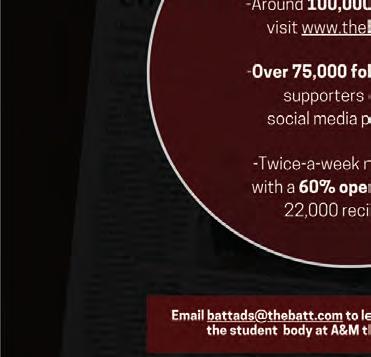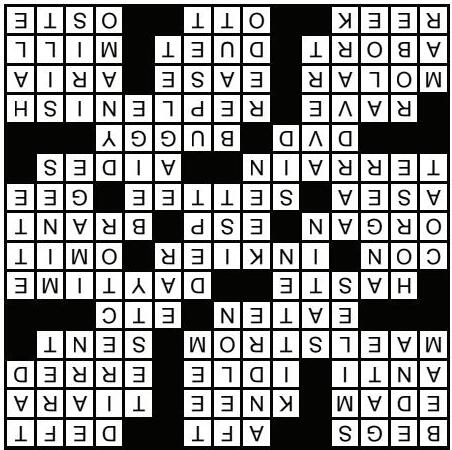
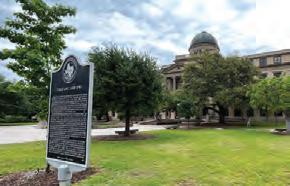


SILVER TAPS Lucas Hitters, Isabella Elaine Ungerman will be honored on Tuesday, Oct. 7, at Academic Plaza at 10:30 p.m. A2




SPORTS
Blacked-out Kyle Field hosts undefeated No. 6 A&M against one-loss Mississippi State on Saturday, Oct. 4 B1






SILVER TAPS Lucas Hitters, Isabella Elaine Ungerman will be honored on Tuesday, Oct. 7, at Academic Plaza at 10:30 p.m. A2




SPORTS
Blacked-out Kyle Field hosts undefeated No. 6 A&M against one-loss Mississippi State on Saturday, Oct. 4 B1

All-in-one platform Aggieland Serves connects students, faculty, sta with service opportunities across Bryan-College Station
By Avery Kracmer Associate Life & Arts Editor
Dozens of kids rush off the bus in anticipation of the highlight of their day: after-school care at the Boys & Girls Clubs of the Brazos Valley. Among controlled chaos, Texas A&M students teach kids aging from six to 18 everything from multiplication and division to how to throw a football and even how to tie their shoes.
“It is pretty cool to see the light kind of flick on, and they say, ‘Hey, I understand this,’” volunteer and industrial distribution senior Austin Hull said. “It’s pretty rewarding to teach somebody how to do something for the first time, and it’s somebody that actually wants to learn.”
For Hull, serving kids in the community has been a crucial part of his time at A&M — an opportunity he signed up for through Aggieland Serves, a new centralized volunteer-matching platform for service opportunities in Bryan-College Station.
Prior to the recent pilot launch of Aggieland Serves, the Bryan-College Station community lacked a universal service system directly connected to the university for opportunity outreach, Program Manager in the Office of Community Engagement Kimberly Fox said.
From one-offs to one hub
With a community centered around volunteerism and a campus rooted in Selfless Service, Fox recognized the need to match volunteers with community needs. Serving as the connector between local nonprofit organizations and faculty, staff and students, Fox identified a disconnect: Many nonprofits’ biggest challenge was finding consistent longterm volunteers.
“The nonprofits had to do a lot of legwork to reach out to individual student orgs, and it was just a lot of one-offs,” Fox said. “And

and general fees are just $203 per semester credit hour.
those relationships might continue for a couple of years, but then someone would leave a position either at the organization or on campus and that relationship building had to start back over.”
For three years, Fox searched for an all-inone platform. After researching what other Southeastern Conference schools and peer institutions used, GivePulse offered exactly what she was looking for. The new program targeted all students, staff and faculty at A&M creating an easy-access hub for service opportunities across Bryan-College Station.
“Right now, we are just getting things started now that students are back on campus,” Fox said. “So we are trying to find that balance to have the volunteer opportunities available, as well as having the volunteers
the volunteers that they’ve had in the past and follow up with them and just to have a longterm relationship.”
The Boys & Girls Clubs of the Brazos Valley has worked closely with Aggieland Serves in leveraging its platform to maximize daily volunteer opportunities. With a constant need for volunteers, English senior and Program Administrator Rodneshia Broades said the platform brings an opportunity to reach more kids in the Brazos Valley while developing integral skills for Aggies.
“It opens up our volunteer base to reach more students at A&M, and of course, them coming in here to volunteer,” Broades said. “It’s a win-win partnership. It allows students to come and build communication skills, leadership skills, while also they’re positive
We’re all here together for at least four years, right? And so I believe you should leave things better than you found it.
Austin Hull Industrial Distribution Senior
to sign up for those opportunities. So what we’re doing is trying to work with those student orgs and campus organizations to leverage the relationships they already have with nonprofits in our community.”
A lifeline for local nonprofits
Previously, many local nonprofits used spreadsheets, SignUpGenius or traditional pen and paper for their volunteer opportunities. Fox noticed those systems were beneficial for single cases, but for recurring volunteer events, the nonprofits often found themselves in a bind.
“It was really hard to manage the sign-up process, the check-in process and then any reflection and follow-up afterward,” Fox said. “Where they may have had to do that in three different ways, now that can all be done through Aggieland Serves, and it’s really easy for them to continue those relationships with
experiences for our youth.”
Broades has watched the volunteer base grow more in recent months than at any other time since starting with the program almost two years ago.
Through Aggieland Serves, the Boys & Girls Clubs of the Brazos Valley is able to send feedback forms and reflections to volunteers to complete in order to continue improving the program and maintaining long-term relationships with volunteers.
“Those reflections are a game changer,” Broades said. “It also allows those who are interested in volunteering at the club to see other people’s experiences, to kind of figure out if they want to serve in other ways. One of the things that I love hearing the kids say is that they want to go to Texas A&M one day. And I think, in part, a lot of that is because they get to talk to the Aggie volunteers when they’re here, and that mentorship relationship that they have with the kids.”
Hull, a frequent Boys & Girls Clubs volunteer, learned about the platform through his men’s organization at A&M, Aggie SUITS. With the organization’s primary philanthropy being the Boys & Girls Clubs of the Brazos Valley, Hull has found volunteering easier to navigate and is better able to keep track of his points through Aggieland Serves.
“It’s important to serve your community,” Hull said. “We’re all here together for at least four years, right? And so I believe you should leave things better than you found it. And with the platform that we’re using, it’s made it really easy to do that and really easy to kind of understand how much you put in and track it that way.”
Biomedical sciences senior and Philanthropy Chair Vineet Erella has led the transition for Aggie SUITS from pen-and-paper signups to Aggieland Serves. Erella said the platform centralizes all of the Boys & Girls Clubs’ service opportunities for the group’s over 70 members and connects the organization to other opportunities in the community.
“One of the main things I wanted to do as a service executive was give my guys as many opportunities as I possibly could,” Erella said. “Service is the first pillar for our org, so I wanted to make sure it’s a big commitment for us, and my thing was just giving those opportunities, and this website makes it a lot easier for that.”
Lessons in action
Aggieland Serves has also established a connection with the College of Architecture — more specifically, the Department of Landscape Architecture and Urban Planning. Senior Program Coordinator Jeewasmi Thapa and Program Coordinator Cedric Shy spearheaded the collaboration for this year’s community initiative in Pine Island; PLAN 661, a community engagement course, uses the platform to bridge the gap of long-term projects, providing pre-and-post surveys accessible to students and professors.











July 17, 2003 - April 5, 2025
Lucas Hitters was an incoming Texas A&M Mays Business School transfer student born in Morrison, New Jersey, on July 17, 2003. He and his family moved to Buenos Aires, Argentina, which is where he spent his early years before moving to Houston alongside his mother, Federica, father, Guillermo, and brother, Matthias. He graduated from Cypress-Ranch High School with honors in 2022.
His parents described him as a talented soccer player, diligent worker, role model and someone who made everyone feel valued.
In December 2022, Lucas was o ered a scholarship to play soccer across the country at Temple in Philadelphia where he played as a forward and studied exercise and sports science. His academic career took a turn in Spring 2024, when he transferred to Indiana University Indianapolis.
After spending two years across the country, Lucas decided to return home to Texas, leading him right to the heart of Aggieland in the fall of 2024 after deciding to reunite with some of his closest friends. He enrolled at Blinn College and maintained a 4.0 GPA, and in Spring 2025, he was admitted into Mays Business School to pursue a bachelor’s of business administration in management.
Diligent worker
“He was never a procrastinator,” Guillermo said. “ … He was always quite driven and goal-oriented. He knew it was hard to get into Mays Business, but he worked hard to do that.”
During his college career, Lucas was known to be extremely motivated and hardworking. His father said that — despite Lucas knowing how low the odds were of transferring into Mays from Blinn — the challenge of admission was no match for his determination.
“We’ve been at Blinn for two, three years, and he comes in and transfers,” Lucas’ close friend and construction science junior, Hayden De La Cruz said. “He did twice the amount of work we did in the summer, and then gets good grades.”
As a team captain, friend, brother and son, Lucas set an example for others to follow. He maintained a balance between athletics, social life and school, all the while encouraging others to do their best.
“He was balanced very well, the ability to
be respected, the ability to be approachable,” Guillermo said. “He played hard, he worked hard. … He was very, very driven.”
His father and close friends describe him as someone who tried his best in everything he set his mind to. He was incredibly passionate and determined to succeed, despite any di culties that he faced.
“My favorite thing about Lucas is everything,” De La Cruz said. “Speci cally, just his drive and passion for literally everything he did. … The little things that he did every day motivate me so much now.”
Made everyone feel valued
According to his father and De La Cruz, one of Lucas’ greatest strengths was his friendly demeanor and personability.
“Anyone around him was just instantly happy, it’s hard to describe,” De La Cruz said. “He made everyone want to be his best friend and made everyone feel so comfortable.”
De La Cruz said that, as a roommate and as a friend, Lucas brought joy into every conversation, and his smile lit up the room.
“Once he moved in with us, he was the glue,” De La Cruz said. “There wasn’t a bad day around him. Bad days didn’t exist with Lucas.”
After receiving his acceptance into Mays, Lucas continued to pour positivity into his roommates, as they applied to transfer into A&M as well. He never stopped encouraging others and was ready to help at a moment’s notice, De La Cruz said.
“He was just motivating us every single day and giving us the a rmation we needed,” De La Cruz said. “He got into his major, and we were so proud of him. … He was like, ‘Now it’s your turn, you’re gonna get in.’”
Surrounded by family and friends, Lucas was laid to rest on Friday, April 18, at the age of 21, at the Forest Park The Woodlands Funeral Home & Cemetery in The Woodlands. His parents have shared their intention of starting a scholarship at A&M in memory of Lucas and creating a foundation with the goal of supporting research endeavors to nd a cure for nocturnal epilepsy and sudden death from epilepsy.
“The positive note is that he passed away in one of his happiest times ever; he was happy to be with his best friends down in College Station,” Guillermo said. “ … Having been accepted into A&M, he was so proud, we were so proud.”



Ceremony: Tuesday, Oct. 7, at 10:30 p.m. at Academic Plaza.
Warning: There will be gun sounds at the ceremony. Please remember to remain quiet upon arrival.


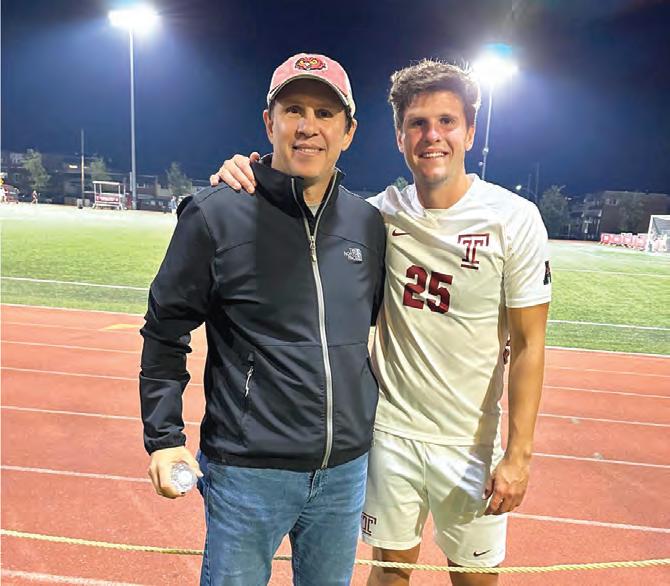

May 2, 2007 - August 24, 2025
At 18 years old, Isabella “Bella” Elaine Ungerman tragically passed away, along with her father, in a car accident. On the way to nishing her move-in to college — a time of new beginnings — things suddenly came to an abrupt end.
During Bella’s life, she managed to touch and in uence the hearts and minds of all around her through compassion, intelligence and pure kindness. Born in San Antonio, Bella grew up with her father, Richard Craig “Rick” Ungerman, her mother, Tanya Ha, and her older brother, Henry Ungerman.

“All her friends love her, and her teachers love her,” Tanya said. “At her funeral service, you know, so many people came, her teacher all the way from kindergarten. Elementary school to middle school and high school. … Yeah, she’s only 18, but she has a lot of people who love her and come to her funeral service.”
This abundance of support stems from the extreme love and care that Bella treated everyone with.
Between helping friends with their schoolwork and making sure that everyone around her was content, she never failed to place the well-being of others before her own.
It is these qualities that prompted her to excel — with the hopes of eventually pursuing medical school in order to become a doctor.
“She was really good in science,” Tanya said. “I mean, she was good in pretty much everything, like English, history, science, chemistry, biology, math. I mean, she’s really good in everything. … She had straight A’s in every subject all the way since elementary until high school.”
Bella didn’t ever let her academic prowess prohibit her from taking care of others.
Tanya recalls a speci c time in high school when Bella studied for hours with her friend to prepare for a science test.
When the day of the test arrived, her friend didn’t do as well as she had hoped. Instead of simply taking pride in her high score, all of Bella’s focus shifted to her friend and what she could do to help the situation.
“I’m just telling you this story to tell how much she cares about her friends,” Tanya said. “She wanted everybody to do well and not, you know, get left behind, things like that. … She just had so many good qualities in her personality. Not only is she smart, but she’s kind, loving and caring.”
Throughout junior high and high school, Bella participated in a plethora of activities, always staying busy and succeeding in everything she put her mind to.
“She liked dance,” Tanya said. “She was in the dance team in high school. She was in the swimming team when she was in elementary school and middle school. In middle school, she did theater. She was in band in middle school, theater and marching band. She played ute. And then in high school, she was in the dance team the whole time. She loved dancing.”
Throughout her participation in these activities, Bella put her all into everything she pursued while making sure to never lose sight of her kindness and conscience.
“Some parents, when your kid [is] getting older, maybe high school, something you are warned they get in trouble, you know, at either academy or work or things like that,” Tanya said. “But she didn’t do anything like that to make me worry.”
Despite her sense of responsibility and maturity, Bella always focused on her joy and the way in which she could spread it to others.
When asked to do the challenging task of describing her daughter in three words, Tanya settled on “Smart, loving and kind.”
“I call her my sunshine,” Tanya said. “That’s my nickname for her, you know, she’s my sunshine. Since she was little, always a cheerful and happy little girl.”



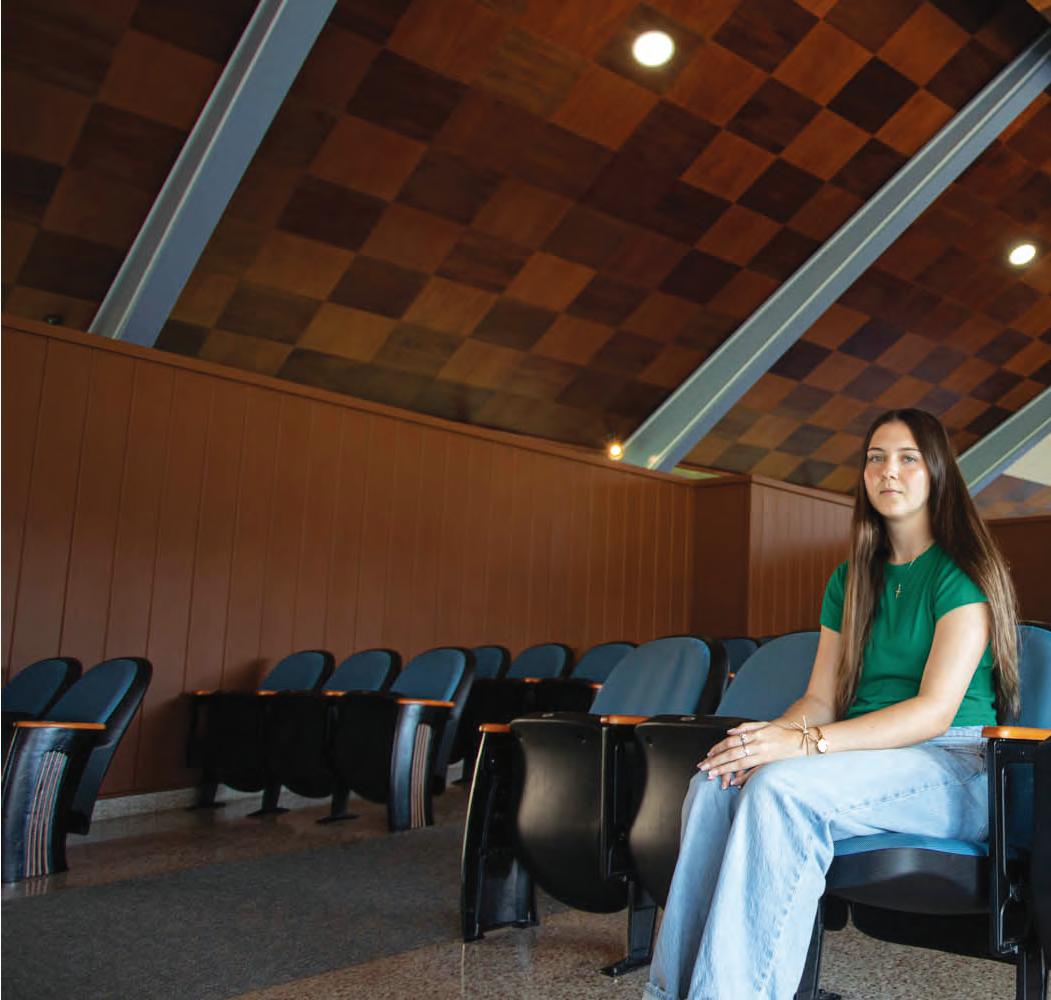


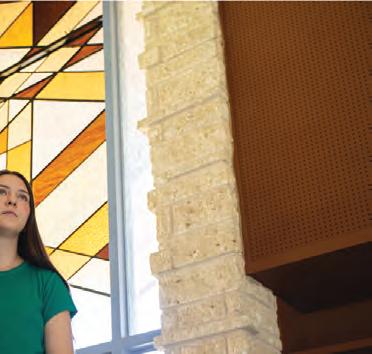



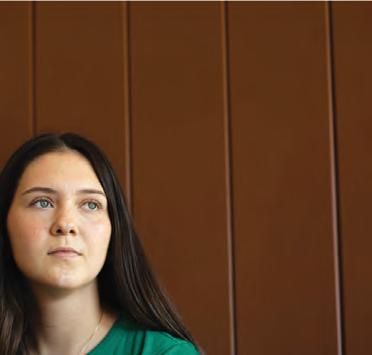

Camp Mystic counselor faces deadly Hill Country flooding, but her faith remains steadfast
By Claire Frazier Life & Arts Writer
All summer, the river was still. Except, of course, for the bass and cat sh cutting through the clear water, glinting in warm spots of sunlight that peaked through oak trees in the Texas Hill Country. The water was cool and bubbled gently in the breeze. Shade danced across the muddy patches of bright green summer grass on the banks.
Just outside of Hunt, in Kerr County, Cypress Creek branched out from the Guadalupe River and trickled past cabins nestled in its meanders. The creek was home to swimming, diving, kayaking and canoeing. It saw generations of young girls learn how to sh. It was the kind of place where girls felt God’s presence and nothing bad ever happened. Until it did.
Education junior and summer camp counselor Kristen Hibert didn’t grow up going to summer camp. In fact, the idea of leaving home had always made her nervous. Two years ago, a friend introduced her to Camp Mystic, a near-century-old Christian camp for girls.
“That was very much a God thing, because I was always terri ed of leaving my parents when I was younger,” Hibert said. “So that was really big out of my comfort zone. But there was no hesitation with wanting to apply.”
When she arrived as a counselor in the summer of 2024, she was swept into a new world of tradition and faith.
“Everyone called it a slice of heaven because you just felt God’s peace there,” Hibert said. “I was met with so much love and just experiencing God’s creation and all of its fullness, rainbows every time it rained, the trees covered the river. It was just so beautiful.”
This summer, she went back in late June and was assigned to the youngest cabin at Cypress Lake, Camp Mystic’s upper site, where the girls were just eight years old and many were away from home for the rst time.
“We reassure [the parents] before they drop their kids o that we’re going to take good care of them,” Hibert said. “They’re terri ed coming in, and we tell them, ‘You’re so brave for signing up.’”
And so her life at Mystic began again. It was built on joy, sisterhood and, most of all,
teaching shing. She connected with the girls on the banks of the river, watching them cast lines into the water.
“Fishing is always so fun because they dam it o , and it’s stocked with huge bass that have been there for 30 years,” Hibert said. “They have cat sh and sun sh, little bluegill, and you have these little eight year olds who are catching 12-pound catsh, doing their hardest to reel in this huge monster sh.”
Every so often, Richard “Dick” Eastland — the longtime owner and executive director of the camp — would drive girls to the Guadalupe camp to cast lines in a di erent pond.
“He would come over in his truck and bring the Cypress Lake girls over to the Guadalupe,” Hibert said. “They thought that was so fun that they got to go into the other camp and sh in their pond. He taught girls how to tie shing knots and how to put on a hook and how to toss a sh back in safely without hurting it.”
For six days, Hibert lived in this peace.
Little voices called out that it had woken them up, too. One camper came up to Hibert’s bed, sobbing, “The thunder’s in my ear.” Hibert prayed with her, asking for Jesus to give them a little peace of mind.
“She knew something was wrong, and I felt so bad,” Hibert said. “I couldn’t do anything.”
When they nally got out of bed on July 4, the power was out. The morning bugle call Reveille hadn’t played to wake them up like it was supposed to. They lingered there in the cabin until senior sta brought them cereal. “Ration the milk,” they said. “Shelter in place.”
“I knew then, something was wrong,” Hibert said. “ ... We’ve never had to ration anything before.”
At noon, Hibert and her co-counselors were nally called to a meeting. The senior counselors stood before them, still in last night’s soaking wet clothes, she noticed. With them was a pale-faced Catie Eastland, the director of the Cypress Lake camp.
“She said that during the night, while
I never doubted that God was good. I never doubted that he was with those girls in their final moments.
Kristen Hibert Camp Mystic Counselor “ “
She enjoyed dining hall food, cotton candy skies and tucking her campers in each night with prayers and promises of tomorrow.
“It was some of the best moments of my year,” Hibert said.
On July 3, every girl showered, brushed their teeth and chattered until Taps played, just like usual.
“Everyone was in bed at a decent hour, and I didn’t think anything of it,” Hibert said. “No one did.”
Then, the rain came.
“I remember it just felt weird,” Hibert said. “I don’t remember what really woke me up, because it wasn’t even bad outside yet. But I couldn’t go back to sleep, and a few minutes later, the rain started just pouring like nothing I’ve ever seen before.”
Thunder and lightning weren’t far behind.
“Next thing I know, I’m woken up by the worst thunder I’ve heard in my life,” Hibert said. “The whole cabin lit up like someone had turned the lights on. I had this pit in my stomach. It just kept getting worse.”
it was raining, the Guadalupe camp [was] completely destroyed,” Hibert said. “Everyone just falls to the oor and starts sobbing. While they were running from their cabins, a huge surge of water had come and completely wiped out a group of eightyear-old girls. Before that, Dick was the one who was leading them to higher land. And she had said, ‘Knowing Dick, he’s probably driving them in this truck to San Antonio.’”
Holding on to that hope, the counselors returned to their own campers.
“We just kept telling them everything’s gonna be okay,” Hibert said.
At dinner, the Cypress Lake girls were nally told what happened and that they needed to go see their families. They were loaded onto buses, complaining about their belongings and the fact that camp was being cut short.
“We knew it was bad, but driving out of camp, big chunks of road were taken up out of the earth, and really big, sturdy oak trees were completely knocked down,” Hibert said. “You looked up and there were cars
wrapped around trees. There were kayaks up 90 feet in trees, and then, looking into the Guadalupe River, it was like a raging sea. It didn’t feel like you were in the peaceful Hill Country.”
At the reuni cation centers, relief and grief battled.
“I’ve never seen a parent hug their child so tightly,” Hibert said.
Hibert had to borrow a phone to get in touch with her own family. She dialed her mom’s number.
“I ended up calling her at night from a random number, and she picks up, which she never does,” Hibert said. “The rst thing she said was, ‘Kristen, baby, are you okay?’” Her mom drove ve hours that night to come pick her up.
“That whole time, I was just sitting with my campers and my co-counselors and girls who I thought didn’t even like me,” Hibert said. “Everyone’s praying for each other.” She made it home eventually, gravely aware of the girls who didn’t.
“There was a lot of survivor’s guilt, and I think there still is,” Hibert said. “I was never angry. I had a lot of confusion because I didn’t understand why the Guadalupe camp and not us. But there was just a sense of gratitude because we saw how awful it was. It was very evident that God’s hand was over the Cypress Lake camp. We didn’t understand why, and some of us still don’t. We never will.”
Now, Hibert spends her days studying at “Quadbucks” or pouring herself into her Christian women’s organization, Delight Ministries.
“I’ve kept in contact with some co-counselors,” Hibert said. “But, I feel like everyone’s doing their own thing now, and not that anyone has gotten over it, but I think we all have the same mutual understanding of, ‘I’m gonna give them their time to grieve on their own.’”
In the six days that Hibert spent as a counselor this summer, Camp Mystic had been her peace. The destructive water in particular was the hardest image for her to reconcile from the camp she knew.
“Fishing was where girls found peace,” Hibert said. “It’s a beautiful pond, and the water’s still. Compared to when it happened, the waters were like a raging sea. It was unrecognizable. And just really sad, because the place that the girls had the most fun turned into something that devastated and took so many lives.”
Yet even in that devastation, Hibert remained steadfast in her faith. It was what Mystic girls did.
“I never doubted that God was good,” Hibert said. “I never doubted that he was with those girls in their nal moments.”










































From mammoth bones to hand axes, ARC preserves history
A&M’s Anthropology Research Collections house, preserve thousands of artifacts, relics
By Liam Bramble Life & Arts Writer
Since the 1970s, Texas A&M’s Department of Anthropology has gathered artifacts from research across the state and beyond. Today, those objects form the Anthropology Research Collections, or ARC, a teaching and research resource tucked away on the third oor of the Anthropology Building.
Inside the ARC are thousands of items — from Civil War relics to prehistoric stone tools — each preserved so students can study, handle and learn from the past.
“It’s mainly … a collection lled with a variety of objects and artifacts from a wide variety of places,” anthropology junior Rafael Montemayor said. “We’ve got stu from both Texas and then also outside of Texas, from like New Mexico, Mesa Verde areas. We even have a remote storage building with boxes stacked full of material — it’s too much to count.”
Montemayor, who is minoring in archaeology and museum studies, has spent his time at the ARC working on exhibit design. One current project focuses on Aggies missing in action from World War II and the Korean War.
“Essentially, one of the history students named Jackson Baker ran a thesis paper where he was … disputing some of the rosters that we had of missing-in-action Aggies and then saying that there was these other sources that we could use in order to gure out who was still missing,” Montemayor said. “He was able to bring down essentially a list of Aggies that have been missing since World War II to Korea … and then after that semester, I was employed by [Katie Custer Bojakowski, Ph.D.] in the summer to actually start making it into a real exhibit.”
Beyond exhibit work, Montemayor said the ARC’s importance lies in the research potential it preserves through saving items collected from previous research projects for future study. With so many artifacts representing only fragments of what once existed, the collection serves as a vital record that will help future researchers piece together the past.
“I think it’s important mainly due to the … research that can be done in the future,” Montemayor said. “Most of the things we have from the prehistoric era are mainly stone tools … we don’t really have any sort of biological or organic artifacts left over. And so for here, it’s really important … to maintain that so we can have an accurate idea of what it was like to live in times past. … It gives us sort of like a lifeline in order to understand ourselves.”
When asked to choose a favorite among the many objects he’s encountered at the ARC, Montemayor didn’t hesitate to point to something large. For him, a large skull stands out among the thousands of artifacts stored in the collection.
“I think it was the woolly mammoth skull … or maybe it was a bu alo skull that we might have had,” Montemayor said. “Yeah, that’s probably my favorite.”
Anthropology senior Lily Dempsey, who also minors in archaeology and museum studies, helps manage the ARC’s teaching collections. These items, which have lost their original archaeological context, are no longer used for research, but instead serve as classroom tools.








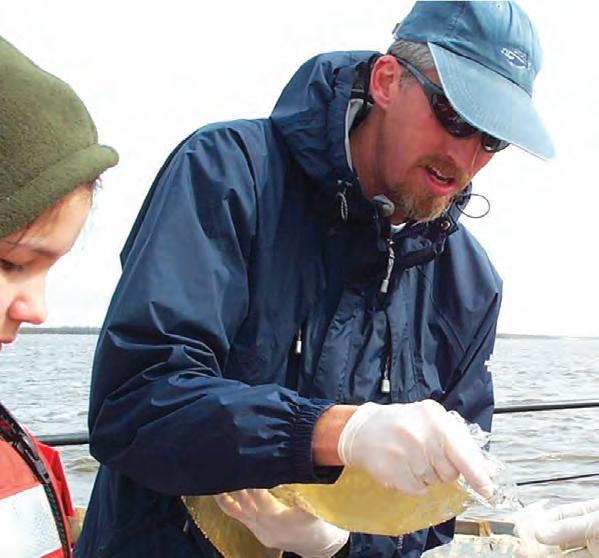



From thawing permafrost to altered nutrient flows, decadeslong global project ArcticGRO yields unexpected results
By Erin R. Wunderlich News Reporter
Somewhere along the northern coast of Siberia in the mid-1990s, Russian researchers and their international colleagues cruised through vast estuaries — where fresh and saltwater mix — on a giant icebreaker ship.
Pausing along the Yenisei and Ob Rivers, they slipped tea-like water into test tubes — the rst steps in a decades-long research project to study how Arctic river systems are changing over time.
NASA estimates that the new global average surface tempature is the planet’s warmest record in 10 years, accelerated by anthropogenic sources such as the release of key greenhouse gases since the Industrial Revolution.
A spike in temperature this drastic has led to a myriad of consequences, including extreme weather events, widespread ecological damage and declining biodiversity.
But what is most worrying to scientists? Arctic permafrost.
largest rivers.
In a 2023 study, the team reported on 17 years of seasonal samples from six major Arctic river systems. The data stems from the Arctic Great Rivers Observatory, or ArcticGRO, a large collection project that is still active today but is now, for political reasons, limited to North American rivers.
One of the project’s goals is to analyze river out ows that serve as “ ngerprints,” tracing Earth’s changes in geography and chemical signature over time.
“Two decades after rst embarking on the Arctic Great Rivers endeavor, we are nding changes across the land-ocean Arctic system that far surpass the 9.5% increase in atmospheric CO2 measured over the period of our dataset,” lead author and University of Alberta professor Suzanne Tank, Ph.D., said in a Frontiers news release.
Alkalinity — the ability of water to neutralize acids like calcium — increased by 18%. This uptick in uences the amount of CO2 released from rivers into
Rainer
Amon,
Ph.D. Professor of Marine
& Coastal Environmental Science
Microbes are similar to little invisible bugs that live inside both the soil and water of Arctic rivers.They “eat” dissolved organic carbon for energy and breathe it out as CO2, just like humans.
This means that thawing permafrost releases carbon directly into the atmosphere, bypassing the river system and Arctic Ocean altogether.
“This is why it is important to go upstream, close to where the permafrost is melting — that’s where the action is happening,” Amon said. “But the reality is that there are many barriers to getting that data: geopolitics, remote locations, international collaboration and, the big one, funding.”
Operating an icebreaker, a ship built to plow through frozen seas, can cost more than $100,000 a day, plus nearly $1 million in diesel fuel. Germany’s next-generation icebreaker, slated for completion in 2030, carries a price tag of over $1 billion. Few nancial backers can provide that level of support, making the search for grants especially challenging.
In the Arctic, climate change is not a political opinion — it’s scientific reality.
Surface temperature in the Arctic region has increased three to four times more than the global average, clocking in at 3 degrees Celsius.
“In the Arctic, climate change is not a political opinion — it’s scienti c reality,”
Texas A&M Professor of Marine & Coastal Environmental Science Rainer Amon, Ph.D., said. “There is a large amount of organic carbon locked up in the North’s Arctic permafrost. It’s almost twice the amount of what’s currently found in atmospheric [Carbon Dioxide]. The annual loss of permafrost will have substantial e ects on river chemistry and CO2 concentrations in the atmosphere.”
Amon said that human activity has pushed the planet to a point of no return and that Earth’s system itself might become a carbon source rather than a sink, with thawing permafrost naturally fueling rising temperatures globally.To study the e ects of a melting Arctic, Amon and an international team of scientists looked to the Arctic’s
the atmosphere. Nitrate — an important nutrient for plants — decreased by 32%.This means there are fewer nutrients available to aquatic ecosystems, negatively impacting food webs in the rivers and nearby coastal areas.
But what surprised ArcticGRO researchers was that dissolved organic carbon — the carbon stored in permafrost that has now melted into river water — showed no change despite a huge loss of ice and a drastic increase in Arctic surface temperatures.
“The Arctic is changing very fast,” coauthor and senior scientist at the University of Chicago’s Marine Biological Laboratory James McClelland, Ph.D., said. “These results bring more questions to the table: How does this organic matter decompose? Where? How does it in uence the coastal ecosystems it’s decomposing in?”
Amon theorizes the dissolved organic carbon is being respired by microbes early on.
Despite these challenges, McClelland stresses the importance of this research as global temperatures continue to rise.
“What happens in the Arctic does not stay in the Arctic,” McClelland said. “When permafrost thaws at high latitudes, CO2 is released to the atmosphere and a ects the global climate. It’s not just some far-o place where maybe things are changing fast. Those things don’t just matter to the organisms and people living up there — they matter to all of us. It has implications for how global ocean circulation works. That’s why it’s so important that we continue to study these trends.”
Amon’s work to maintain monthly river collections with colleagues in Siberia ended in 2022 amid political tensions, so he is now recruiting graduate students to help analyze those samples.
But access to the rivers’ source points — the ultimate goal — may stay out of reach for now.
“What people should take away from this study is that things are moving, they are changing,” Amon said. “Yes, they have always changed, but they have never changed as fast as they are now. We need to get a handle on it.”

It’s not about if choices are good or bad — they’re her own
By Joshua Abraham Opinon Columnist
Spoilers ahead for “The Summer I Turned Pretty.”
As the hit show and cultural phenomenon
“The Summer I Turned Pretty” reached its series nale and has fans awaiting a newlyannounced lm, viewers from watch parties in bars to living rooms have uttered one phrase throughout the entirety of the show: “What the hell is happening?”
This phrase summarizes the complete insanity of the series and the actions each character makes always seem to be the most outlandish; fans are left scratching their heads after each episode, trying to digest the seemingly bizarre drama- lled plot.
It’s like if the writers went into the writer’s room and spun a roulette wheel to decide the fates of the characters, leaving everything up to chance. You never know what is going to happen, everyone is the worst version of themselves, and having a series of characters lled with that mentality is incredibly entertaining but also a little horrifying.
Now I want to focus on one person in particular. As the question across social media has always been whether you’re #TeamJeremiah or #TeamConrad, and there’ve been arguments for each, there’s





one answer that I can be con dent in — I am not #TeamBelly.
I’ve given her too many chances, and she’s failed me every time. It’s insane that she doesn’t have to bear any repercussions for her actions, especially not as much as Jeremiah and Conrad.
In case you aren’t familiar with the show, let me tell you how insane Belly is.
Growing up, her childhood crush was Conrad. She bounced back and forth between kissing Conrad and his brother Jeremiah before landing on Conrad. She dated him but then broke up with him later. She moved on to Jeremiah, and they stayed together for four years, dating well into college.
After running back into Conrad, she questions her current relationship and, while she gets engaged to Jeremiah, she can’t forget that she still has feelings for Conrad. Her state of mind constantly changes throughout the series, and it drives her questionable actions — which impacts everyone around her.
She made the funeral of Conrad and Jeremiah’s mother about herself, storming out and causing a scene. She set up her wedding only to cancel it and then ew to Paris with no student visa or spot in the study abroad program that she personally rejected, running away from everyone.
Every decision she makes is made without thinking anything through, ignoring everyone else in the process, even though many people only look out for her well-being.
The reactions I’ve seen to Belly are
justi ably angry with her inability to choose between the two brothers, but something I won’t tolerate is judging how and why she makes the decisions that she makes in the show.
Whenever we see other people doing things that we think are wrong, we forget to put ourselves in their shoes. Judgment is a human characteristic, but so is empathy, and that’s something we’ve all forgotten.
Belly’s choices aren’t just terrible: They’re her own. Most of the time, when we’re faced with big, life-changing choices, our decisions come not from a place of rational thought but rather a gut feeling, which Belly relies on heavily throughout the show. Our intuition is what guides us through life. It’s human to make decisions that don’t bode well in the long run — we aren’t perfect. If everyone were perfect beings and made perfect decisions, where would room for growth be? We fail, but we get back up. We learn and move on.
Belly is human, just like you and me. She may just be a television character, but she represents something that everyone can relate to — the feeling of uncertainty about whether or not what we’re doing is right. There’s always going to be something better, something bigger, something bolder that can change our lives for the better. It’s our job to make the decision on if we want to take that chance, even if the choice isn’t clear at that moment.
So, even though the writers might’ve been playing with Belly’s life throughout the entire series, they allowed her to be human, not to do right or wrong but to do
things that she sees t — as good or bad as the outcome may be. Yes, it gets messy, but that messiness allows for growth.
At the end of the day, we’re all human beings trying to make the right choices in our lives. There’s no “Which brother would you choose?” game because there isn’t a winner. You make your choice and you move on.
And guess what? Belly ended up with the man she wanted. If every bad choice led her to the right one, who are we to judge her? She got what she wanted, and that’s all one could ask for.
I may not be #TeamBelly because I don’t agree with everything she did, but I believe that she deserves the right to make the decisions she wants to make.
Everyone makes these kinds of choices, even though they probably aren’t as drastic as hers. We should be judging less and empathizing more, because we would want the same type of grace if we were in her shoes.
Instead of #TeamConrad or #TeamJeremiah, I’m #TeamBeingAHuman. Everyone is living their rst life, and so is Belly. We might suck at it, but we get better, just like Belly did. Some moments we feel like we’re having the best summer ever in the ctional New England town of Cousins Beach, but others feel like we’re on a tearyeyed ight to Paris.
Neither is better than the other; we just have to do what we want to do.
Joshua Abraham is a kinesiology senior and opinion columnist for The Battalion.
Has the nighttime talk show scene begun to fade to black?
By Maeva Elizabé Opinon Writer
“Late night began as a way to kill time.”
That was said by Conan O’Brien during his appearance in the pilot episode of “The Story of Late Night,” a docuseries tracing the origins of talk shows.
He meant that statement literally, for prior to the advent of late-night talk shows in the 1950s — yes, they’re that old! — network television programs ended at 11 p.m. There was nothing but static for a few hours in the dead of night.
For the Americans who grew up with programs disseminated on a mere three channels that had to be changed with dials and tuned with antennae on a television set that no burglar dared burgle for fear of throwing their back out, late night became the talk of the town, especially when Johnny Carson entered the spotlight in the 1960s.
Blending unprecedented charismatic appeal with spot-on comedic timing, Carson established nighttime talk shows as a pillar of American pop culture. Nightly, almost ritualistically, millions of families would gather on their sofas — likely covered in plastic, if you know, you know — to watch a celebrity chat on a similar sofa, thousands of miles away, yet mere feet in front of their starstruck eyes.
But nowadays, the lack of something — anything — being perpetually broadcast is a notion many of us may nd hard to conceptualize as a generation spoiled by ondemand streaming platforms like Net ix, Hulu and countless others.
Now, have Americans just stopped watching cable television cold turkey? Of course not. Football season is in full swing; Americans

aren’t savages. Nor have they just collectively decided that getting the worm really is more rewarding than being a night owl.
Media consumption trends and attention spans have simply changed in the past decade, with audiences gravitating toward easily-accessible YouTube clips and podcasts instead of tuning in for shows that increasingly rely more on dull, scripted moments than engaging guest appearances.
The most memorable pearl of wisdom
O’Brien allegedly received from Johnny Carson in 1993 during his late-night tenure is Exhibit A of the in ltration of such “streamoholic” phenomenon in modern society.
“As soon as possible, get to a streaming platform.”
While this exchange very likely didn’t happen — hello, anachronism! — the message of the ginger-haired host’s humorous quip is clear: The entertainment landscape is evolving, and rapidly.
Binge-watching habits aren’t merely starting to slowly gain traction, but are spreading like wild re.
While the shift induced by the birth of late-night shows was more akin to primary succession, with pioneering hosts gradually building the legacy of broadcast services from its bare bones, the explosion of streaming services already has a foundation from which it is swiftly shooting up to establish a climax community of streaming junkies.
And with evolution comes natural selection, so lately it’s become a question of which television personalities will prove themselves the ttest to survive the whims of the latest viewership trends.
In essence, you’d better stay ahead of the curve.
The curve in question? That of the declining ratings and revenue of late-night talk shows.
And the slow demise of these programs is looking more and more like the plot of an
Agatha Christie murder novel. Starting with the end of James Corden’s “The Late Late Show” in 2023, and more recently Jimmy Kimmel nding himself in hot water and Stephen Colbert announcing his show’s cancellation earlier this year, the mainstream prospects are getting picked o one by one. And soon, there will likely be none to carry the torch.
But audience engagement isn’t the only factor at fault for the stagnant success of talk shows.
At rst, the peak years of late-night program prosperity re ected an era of shared cultural values, of rising stars and satirical banter that touched upon hot societal topics in lighthearted, entertaining ways.
But the banter isn’t so lighthearted anymore.
Similar to many other facets of contemporary daily life, talk shows seem to be one of the latest casualties of the growing hostilities brought about by incendiary political tensions.
Monologues are increasingly infused with vitriolic commentary, and hosts are constantly walking on eggshells and dodging landmined jokes out of fear of being blasted to bits on social media.
Americans are becoming so fragmented that we can’t even enjoy a meager hour of human interaction without picking apart the smallest details and throwing insults at each other.
So is it really time to pull the plug on latenight talk shows? Or do we all just need a reality check to get the bigger picture back in focus?
Say what you want about them, but at least giving those old television sets a good slap when they lost connection always seemed to do the trick.





Man prepares to rattle Mississippi State in blackedout Kyle Field on Saturday
By Roman Arteaga Senior Sports Writer
A loud, blacked-out 12th Man will aim to make a statement when conference rival Mississippi State visits Kyle Field on Saturday, Oct. 4.
No. 6 Texas A&M football has started 4-0 for the rst time since 2016 and will look to re o an o ensive salvo with redshirt sophomore quarterback Marcel Reed at the helm. The Fightin’ Farmers will need to emphasize two things: ensuring Reed’s execution through the air and stopping the Bulldogs’ running game.
For the Aggies’ o ense, sophomore wide receiver Mario Craver will look to torch his former team with his electrifying speed, route running and catching ability. He has already posted 24 receptions for 477 yards and four touchdowns.
O ensive production has not been a problem this year for the Aggies, as they are averaging 464 yards of total o ense per game with other major contributions coming from senior running back Le’Veon Moss and NC State transfer junior WR KC Concepcion.
Moss is coming o of a stellar showing against Auburn, rushing for 139 yards and a touchdown on 21 carries. A key part of A&M’s o ense, Moss now stares down a Mississippi State defense that gives up 154 yards per game.
“Our players of the week, obviously Le’Veon Moss,” coach Mike Elko said during his Monday press conference. “He carried the load for us on o ense, and he had a really good day running the football against a strong rushing defense.”
Reed has done a great job under center, throwing for nine touchdowns with just two interceptions through four games with a completion percentage of 64% or higher in three of those games. His athleticism and improved passing ability could terrorize the Bulldogs’ defense while the sound of cannon re rings in his ears.
Mississippi State is lled with experience on its defensive line, returning notable contributors like the rising tandem of redshirt senior defensive lineman Kedrick Bingley-Jones and redshirt junior DL Trevion Williams, who have combined for 21 tackles on the year.
Redshirt junior DL Jaray Bledsoe arrived via the transfer portal from Texas and has made solid contributions, tallying nine total tackles and two tackles for loss on the year. Returning redshirt senior cornerback DeAgo Brum eld and Old Dominion transfer senior safety Jahron Manning anchor the secondary and will look to disturb the Aggies’ passing game, as both have recorded an interception this season.
While getting past the Bulldogs’ defense is important, stopping their running game is also key to winning the ballgame, as Mississippi State has averaged over 200 rushing yards per game. South Alabama transfer sophomore RB Flu Bothwell has been a crucial component in the Bulldog o ense, coming o of a 134-yard, twotouchdown performance in last week’s overtime loss to No. 15 Tennessee.
“It has been a constant conversation, emphasis, drill work, everything we can to x [the run defense],” Elko said. “Over the last few games, we have done a better job at that. … If we can keep the ball inside of us, we have a shot.”
A&M holds some experience on its defense as well in graduate defensive tackles Tyler Onyedim and Albert Regis. The defensive line will aim to disturb Mississippi State’s graduate student QB Blake Shapen, who has had success throwing the ball with eight touchdowns and three interceptions on the year.
Redshirt senior defensive end Cashius Howell and redshirt sophomore DE Rylan Kennedy will do their part in containing Bothwell, while also disrupting Shapen. Howell has paid dividends for this defense, already tallying four sacks and ve tackles for loss so far this season.
Redshirt senior CB Tyreek Chappell, senior CB Will Lee III and redshirt sophomore CB Dezz Ricks will also play their part in the secondary, locking down receivers and making open- eld tackles to stop Mississippi State’s o ense.
“It allows us to get into some structures defensively that puts less stress on the defensive line,” Elko said about the secondary’s high level of play. “The stronger you feel about your secondary the more they can get into isolation situations, the more it allows the defensive line to feel single-gap minded.”










For A&M to be successful in this game and stay undefeated, the Aggies must utilize their weapons on o ense while simultaneously breaking down the Bulldogs’ advances. Setting the tone early will be critical in what will surely
and hostile environment for the

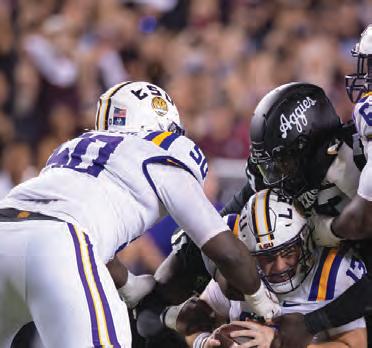




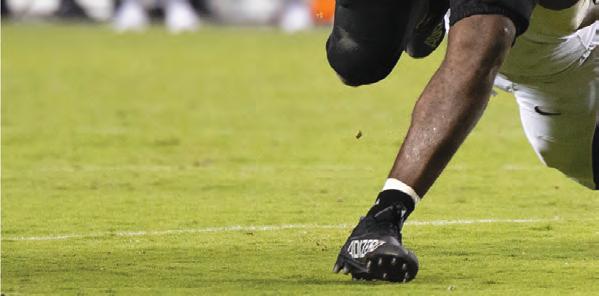



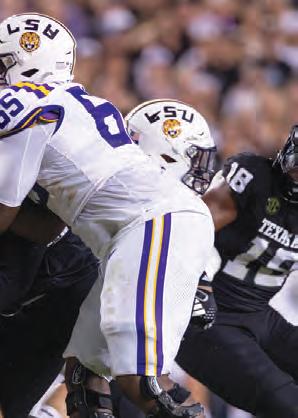


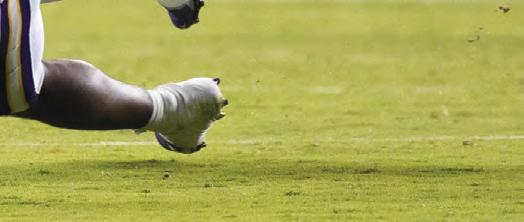








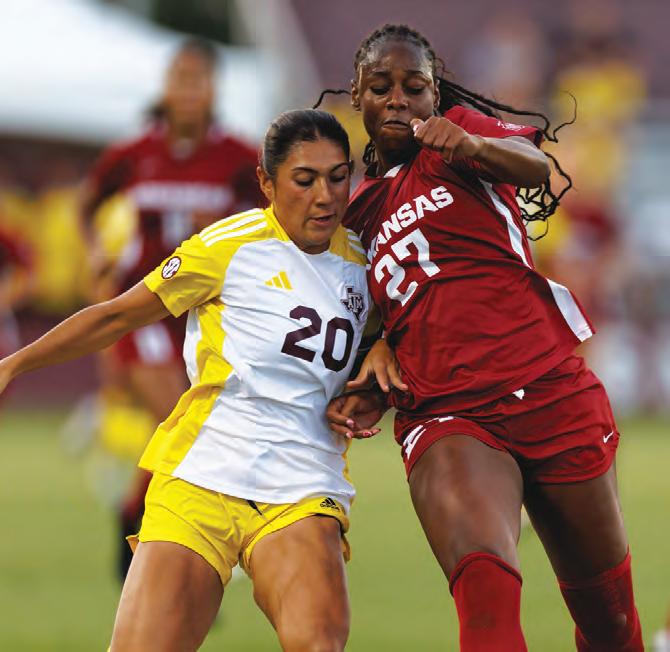

Aggies aim to break scoring drought, earn their first regularseason win against struggling Longhorns in front of 12th Man
By Diego Saenz
Senior Sports Writer
The Lone Star Showdown returns on Thursday, Oct. 2, this time on the pitch, as Texas A&M soccer hosts Texas at Ellis Field. After slow starts to their Southeastern Conference campaigns, both teams will enter the match looking for redemption. The Aggies are winless in their last six games, dropping ve of those contests while being outscored 8-1, leaving the Maroon and White at the bottom of the conference standings.
The Longhorns haven’t been doing too hot, either. Texas sits just a couple of spots ahead of A&M with a mere three points, having lost three of its rst four SEC games.
While the usual phrase might be “unstoppable force meets immovable object,” this year’s Lone Star Showdown seems more ttingly described as “stoppable force meets movable object.”
Through four SEC games, A&M’s attack has yet to nd the back of the net. On the other hand, Texas has given up 11 goals in its rst four SEC matches. On Thursday, one of the two will have to give way. Nonetheless, it’s a good bet that the A&M attack will prevail. During its eight-game non-conference slate, Coach G Guerrieri’s squad was scoring at a high rate, netting 20 goals on their way to an undefeated start. Its last goal came in the 2-1 loss to No. 4 TCU on Sept. 7.
Junior forward Leah Diaz was responsible for the Aggies’ last goal, and getting her involved would be a good rst step for A&M to reignite its attack.
Diaz started the season strong, recording three goals and four assists while serving as the engine of the team. She currently leads the squad in scoring alongside junior mid elder Trinity Buchanan and junior
F Kaylee Noble, both of whom have also been quiet in recent weeks.
Fortunately, there’s a perfect opportunity this week to snap that scoring drought, and what better stage than against a Texas defense that’s been struggling as of late?
To start o SEC play, coach Ange Kelly’s program lost 3-1 to Missouri, 3-0 to No. 13 Mississippi State and 4-3 to Alabama. Texas is coming o of a 2-1 win against No. 24 Vanderbilt, but its defensive issues have been a problem all season.
Texas has conceded at least one goal in every match this season, good for 25 goals in 11 games — averaging out to 2.27 goals allowed per contest. Meanwhile, the Aggies have been creating chances over the past four games, totaling more than 39 shots. One of those opportunities is bound to nd the back of the net.
“It’s tough when you create so many chances, and the ball doesn’t go in,” Guerrieri said after the Arkansas game. “Eventually, luck has to turn. We got to have a little bit of luck on our side to put ourselves in position.”
That luck didn’t swing A&M’s way last Friday, as the Aggies fell 1-0 to No. 5 Tennessee. Still, A&M has remained competitive against top-ranked teams, losing by just one goal to then-No. 4 TCU, then-No. 10 Arkansas and Tennessee.
Now, with an unranked opponent ahead, A&M has reason to feel con dent. Historically, the Aggies have dominated the Lone Star Showdown, leading the series 21-7-2.
The most recent matchup, however, saw the Longhorns take a 2-0 victory in last season’s rst conference match between the two since 2011. Texas went 17-4-2 and won the SEC Tournament Championship last year. This year’s squad, however, is far from that form. With a struggling Texas team coming to College Station, A&M has a prime opportunity to reclaim the Lone Star Showdown. The key question will be whether A&M’s attack can nally break through, or if Texas’ shaky defense will wash away the Aggies’ scoring drought.
The game kicks o Thursday at 7 p.m. under the lights of Ellis Field.
Offseason workouts, exhibition matches mark next chapter of Aggie diamond sports as both seek return to national spotlight
By Noah Ruiz
Senior Sports Writer
Home plate and the 12th Man have waited a long time for the return of Texas A&M baseball and softball, hopeful that both Aggie squads have Texas-sized comebacks while they wait to be called out of the dugout.
Disappointment de ned the outcome of the Aggie diamond sports as a pair of No. 1 rankings proved meaningless as neither team ended last season with a deep postseason run.
Year 1 under coach Michael Earley was a roller coaster of streaks and question marks, as the Aggies saw their preseason topranked team drop out of the polls quickly after an early-season downturn. To make matters worse, A&M became the rst consensus preseason No. 1 team to not reach the NCAA Tournament.
Heading into Year 2, Earley has the chance to bounce back, as he and his sta return several key starters and add a handful of highly anticipated transfers into the fold.
Additionally, two leaders in junior outelder Caden Sorell and junior third baseman Gavin Grahovac return to Aggieland — each ready to make amends for previous woes after combining for 48 home runs in their careers.
Earley and Co. made it a top priority this year to reload their depleted arms by going out into the portal and grabbing bigname transfers, including junior shortstop Chris Hacopian from Maryland and senior OF Jake Duer from Florida Atlantic. The pair are being brought in to ll two massive pairs of cleats, as OF Jace LaViolette and SS Kaeden Kent each departed Olsen Field for the 2025 MLB Draft.
When it comes to pitching, the Aggies are in for quite the remodeling project after their three 2025 regular starters are o to the next step of their baseball journey.
Luckily for A&M, redshirt junior left-handed pitcher Shane Sdao is back in the mix to reprise his role as an everyday
starter on the mound. Another starting-caliber player is sophomore LHP Caden McCoy, an Indiana native that made his case for a weekend-starter role late last season.
Going a little further down the road to Davis Diamond, A&M softball had a different twist of fate to their once-promising season.
Coach Trisha Ford had her squad poised for a deep playo run when it hosted the Bryan-College Station Regional as the No. 1 seed in the NCAA Tournament, but — unfortunately for the Aggies — they would be on the wrong side of history when the regional came to a close.
After falling to Liberty in a best-of-three series, A&M made history again, becoming the rst No. 1 seed to not advance past its own regional.
However, the year didn’t end without hardware, as the Aggies were named Co-Champions of the 2025 Southeastern Conference Tournament after a rain delay gave the SEC honor to both Oklahoma and A&M.
After the departure of star LHP Emiley Kennedy to the Athletes Unlimited Softball League, Ford hit the portal in an attempt to revamp the bullpen and pick out a starter to command the circle.
Senior LHP Taylor Pannell arrived in College Station after serving as a long-time closer for Missouri, looking to translate her previous SEC experience into success in Aggieland.
When it comes to returning talent, the Aggies have the advantage of bringing back one of their most productive players from last season in sophomore in elder KK Dement. The Selma, California, native had no problem adjusting to life in maroon and white, setting A&M freshman records with 18 doubles and 64 RBIs.
Her counterpart, junior INF Mya Perez, will complement Dement to create one of the SEC’s strongest in eld duos as they attempt to climb back into the national spotlight with a treacherous SEC slate ahead of them. Perez, a fellow Californian, was a Second Team All-American in 2025, breaking a 43-year old program record for single season RBIs with 73 to her name.
Though disappointment de ned the fate of both Earley and Ford’s units, there is hope that each can learn from the mistakes of the past and atone for their shortcomings with a season all of Aggieland can hang its hat on.





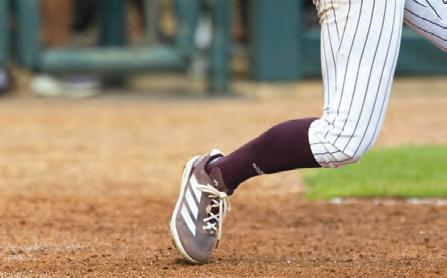






With Mississippi State looking to upset No. 6 Texas A&M, both teams will put their trust in these key contributors
By Olivia Sims Senior Sports Writer
Starting the season 4-0 for the rst time since 2016, No. 6 Texas A&M hopes to continue its winning streak when it hosts Mississippi State on Saturday, Oct. 4.
With the all-time record tied at 9-9 between these two programs, A&M is searching for its rst 5-0 start in nearly a decade, while Mississippi State is looking to bounce back after su ering an overtime loss against then-No. 15 Tennessee after starting its season 4-0 for the rst time since 2014.
Terry Bussey, sophomore wide receiver, Texas A&M
The former ve-star recruit has yet to break out as a weapon for the Aggies, but sophomore wide receiver Terry Bussey’s time is coming soon. Last season, he served primarily as a return specialist and appeared for select packages of o ensive snaps.
Bussey has had at least one reception in each game so far this season, as well as 204 yards o of kick returns through four games. The sophomore continues to be on the eld for kick returns and has also added reps at wide receiver, but he is still looking to establish himself as a permanent xture on o ense
Marcus Ratcli e, junior safety, Texas A&M
In his third season with the Aggies, junior safety Marcus Ratcli e has been a key factor on the defense, already accumulating 20 tackles and a career-high three passes defended through four games.
In the Aggies’ thrilling 41-40 win over Notre Dame, Ratcli e tied his career-high with eight tackles against the Fighting Irish. He is still searching for his rst interception this season, after coming away with three last year.
Cashius Howell, redshirt senior defensive end, Texas A&M
After a monstrous game against Utah State where he recorded three consecutive sacks, redshirt senior defensive end Cashius Howell has not slowed down. The Missouri native currently leads the Maroon and White in sacks with four, accounting for a loss of 24 yards.
With the 12th Man behind him, Howell has been excellent this season at home, where he has recorded all four of his sacks. The Bulldogs’ o ensive line will need to be sharp; Howell is not afraid to take down the quarterback or cause disruption in the run game.
DJ Hicks, junior defensive tackle, Texas A&M
During the matchup against Auburn, junior defensive tackle DJ Hicks had a solid
































showing as he recorded his rst sack of the season. The sack from Hicks came late in the rst quarter, forcing the Auburn o ense to ght on second and long — ultimately resulting in a punt.







During the Aggies’ 41-40 victory over Notre Dame, Hicks had a career-high four tackles, including two tackles for loss. He has become one of the Aggies’ most dominant pass rushers this season, leading the position room with six tackles.
Jordan Mosley, redshirt senior wide receiver, Mississippi State







The fth-year senior was able to make a statement last season with the Bulldogs as he nished second on the team in receiving yards with 405. Although redshirt senior WR Jordan Mosley was not one of the rst receivers targeted for the Bulldogs, he’s been used in each game this season except for one.




Mosley has had a couple of long receptions this season, including a 75-yard touchdown reception against Alcorn State, where the Bulldogs came out on top, 63-0. In Mississippi State’s overtime loss against then-No. 15 Tennessee, Mosley had a season-high three receptions for 20 yards, averaging 6.7 yards per catch.






Jahron Manning, senior safety, Mississippi State
In his rst season with the Bulldogs, senior S Jahron Manning is already o to an impressive start as he has accumulated 27 tackles over ve games. In Mississippi State’s upset win over then-No. 12 Arizona State, Manning had nine tackles — tying for rst on the team.



Manning was able to pick up his rst interception of the season against then-No. 15 Tennessee, where the Bulldogs took the Volunteers into overtime.
DeAgo Brum eld, redshirt senior cornerback, Mississippi State









Redshirt senior cornerback DeAgo Brum eld has already surpassed his number of total tackles from last season, currently sitting at 16 through the 2025 campaign. As a cornerback, Brumeld has already picked up an interception earlier this season and become a reliable starter.


His best game thus far has been against Arizona State, where the Bulldogs took a late lead and were able to secure their rst home non-conference ranked win since 1991.
Xavier Gayten, sophomore running back, Mississippi State














As a true freshman in 2024, sophomore running back Xavier Gayten rushed for 115 yards. As a sophomore, Gayten already has two touchdowns and is well on his way to surpassing last year’s mark, currently sitting at 95 yards on the ground.



Gayten averages the most yards out of the Bulldogs’ running back room with 11.9 yards per rush. While he has only eight receptions so far this season, he has two rushing touchdowns and is still looking for his






































